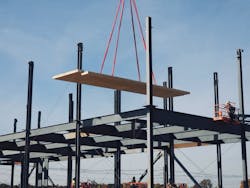Microsoft Employs Wood Products to Help Decarbonize New Data Center Construction
The first of two revolutionary data centers being built by Microsoft is underway in Northern Virginia. It’s not often the term “revolutionary” is used to describe a building technique that might well be the first one used by humans, but choosing to build a data center out of wood can be described as little else. And to be fair, while wood is being used as a major component of the construction, the new data center also makes use of steel and concrete.
As part of Microsoft’s decarbonization effort, in which the hyperscaler’s goal is to become carbon-negative, not simply carbon-neutral, by 2030, the new data center is making use of a product known as Cross-Laminated Timber (CLT). Made by stacking layers of solid wood boards in alternating directions, bonding them with adhesives, and then pressing them together to form strong, durable panels, CLT is what is known as an engineered wood product.
While it may sound similar, CLT is not plywood; CLT is made by stacking solid wood boards in layers, with each layer oriented perpendicular to the one below it, while plywood is made by peeling thin sheets from logs, which are then glued together in layers, with each layer’s grain direction rotated by 90 degrees relative to the one below. While plywood is generally produced in 4’ x 8” sheets no more than ¾” thick, CLT can be several inches thick and produced in units up to 10’ wide and 60’ long.
CLT’s inherent strength makes it suitable for use in structural applications while building (i.e. roofs, floors, and walls). It is designed for load-bearing applications, with the manufacturing technique and material (solid boards) giving it strength in both directions and is considered suitable for use even in high-rise construction. CLT was introduced in Germany and Austria in the 1990’s, but didn’t see very much adoption in the US until 2015 when it was recognized as a code-compliant construction material in the International Building Code (IBC).
Environmentally Sound and Very Green
By using CLT, Microsoft expects to reduce the embodied carbon footprint of the current project and a second, planned, new data center by 65 percent compared to average precast concrete construction and 35 percent compared to conventional steel construction.
Since CLT is a wood product, it sequesters carbon for the useful life of the building resulting in reduced greenhouse gas emissions when compared to concrete or steel construction. And its manufacture has lower energy demands than steel or concrete. And, of course, it’s wood, which is a renewable resource itself, and as part of the supply chain, can be sourced from sustainably managed forests.
CLT panels can also be prefabricated to produced to exacting size requirements, reducing production and building waste, as well as being reused or easily recycled which can further reduce the environmental impact of using CLT, especially when compared to traditional concrete and steel building materials.
So why isn’t there greater interest in the use of CLT in building projects?
Obviously, most construction projects tend to focus on costs and efficiencies, and using new materials always gets some resistance. For example, even though CLT has been approved for use in the US as a certified building material for almost a decade, there are still only a limited number of manufacturing facilities in the US.
Additionally, there are regulatory hurdles that have to be addressed as a lack of familiarity with the product means that it is often not addressed in local regulations.
And, of course, there is the issue that CLT can be more expensive than traditional wood products, concrete, and steel, which, when added to the lack of experienced builders familiar with the material, can result in an increased cost for CLT construction, without really obvious benefits to businesses unfamiar with the advantages of the product or looking to minimize their carbon footprint.
What Else Is Microsoft Doing to Decarbonize Their Construction Efforts?
This isn’t the first move that Microsoft has made to moving towards more carbon-efficient building materials. Two significant investments were made in 2023 to enhance their decarbonization efforts.
In January 2023 the Microsoft Climate Innovation Fund invested in the company Boston Metal. The company uses a process called Molten Oxide Electrolysis (MOE). Unlike traditional steelmaking, which uses processes like blast furnaces in the production process, this direct electrolysis process reduces metal oxides without the need for carbon, eliminating carbon dioxide emissions. Electricity is used to heat the ores, and by using renewable electricity sources MOE can become a fully sustainable method of metal extraction, which releases oxygen, not carbon dioxide as part of the production process.
In 2023, Microsoft was also seen investing in concrete production processes that would reduce embodied carbon. In building at their Quincy data center site Microsoft experimented with different methods of working with biogenic limestone, produced by Minus Materials. Their climate fund has also invested in companies producing other carbon neutral or carbon negative materials such as Carbon Cure and Prometheus Materials.
In a recent video, Microsoft Vice Chair and President Brad Smith explained the need for new innovations in concrete, noting the critical role played by Prometheus Materials.
About the Author



